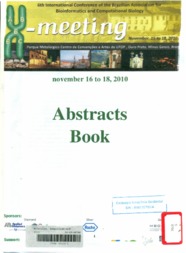Molecular, behavioral and anatomical sophistication in spider webs: insights from spinning gland RNA-seq experiments in primitive and modern spiders.
Molecular, behavioral and anatomical sophistication in spider webs: insights from spinning gland RNA-seq experiments in primitive and modern spiders.
Autoria: PROSDOCIMI, F.; BITTENCOURT, D. M. de C.; SILVA, F. R. D.; MOTTA, P. C.; RECH FILHO, E. L.
Resumo: RNA-seq experiments conducted in 454 sequencers were carried out to produce 87.000 short-reads representing the transcriptome of two spiders'spinning glands. We produced sequences from (i) Actinopus sp., a spider from the Mygalomorphae clade, and (ii) Gasteracantha cancriformis, an Orbicularia spider. Mygalomorphae spiders are known to retain a number of primitive morphological and behavioral characters. They use mixtures of a primitive web, soil, and plants only to cover a burrow they make on the ground for shelter and predation.On the other hand, Orbicularia spiders show a number of derivative spider's characters and they are capable to build different and complex silks used in a variety of situations. It is interesting to note that the complexity of web production, usage and behavior in these spiders is reflected both by (i) the variety of the repertoire of protein molecules (spidroins) they use to make their webs and (ii) the complexity of their anatomical spinning gland apparatu used to produce silk. Here we have first conducted a broad analysis of the spinning gland transcriptome in both spiders producing unigenes and categorizing annotated genes in biological functions.Then we started to analyze the number and variety of spider silk proteins and families found in different spider clades.We have shown that spiders using web only for a limited number of situations present a less sophisticated morphological spinning apparatus and produce a small repertoire of spidroin molecules. Phylogenetic analyses were conductedin the 3'region of spidroins and we try to relate (i) the evolution of silk protein families,(ii) the evolutionary complexification of silk production behavior and web usage, and (iii) the appearance of new specialized spinning glands along the evolution of specimens and clades in the Araneae order.
Ano de publicação: 2010
Tipo de publicação: Resumo em anais e proceedings
Unidade: Embrapa Amazônia Ocidental
Palavras-chave: RNA
Observações
1 - Por padrão são exibidas publicações dos últimos 20 anos. Para encontrar publicações mais antigas, configure o filtro ano de publicação, colocando o ano a partir do qual você deseja encontrar publicações. O filtro está na coluna da esquerda na busca acima.
2 - Para ler algumas publicações da Embrapa (apenas as que estão em formato ePub), é necessário ter, no celular ou computador, um desses softwares gratuitos. Sistemas Android: Google Play Livros; IOS: iBooks; Windows e Linux: software Calibre.
Acesse outras publicações
Acesse a Base de Dados da Pesquisa Agropecuária (BDPA) para consultar o acervo completo das bibliotecas da Embrapa.

